A year ago at this time, the Timberwolves‘ 2022 trade for Rudy Gobert was widely viewed as an unmitigated disaster and a cautionary tale for teams who were considering the idea of selling the farm for a single player.
That blockbuster deal cost Minnesota three solid rotation pieces (Malik Beasley, Patrick Beverley, and Jarred Vanderbilt), a young center who had a terrific rookie season with his new team in 2022/23 (Walker Kessler), the 2023 draft pick that became Keyonte George, and four more future draft assets, including two unprotected first-round picks, a top-five protected first-rounder, and an unprotected first-round swap.
 In their first season with Gobert, the Timberwolves took a step back, winning just 42 games after posting a 46-36 record in 2021/22, and the three-time Defensive Player of the Year struggled to adapt to his new situation. When the 2023 offseason got underway, there were myriad calls from pundits and fans for Minnesota to break up its frontcourt by trading either Gobert or (more likely) Karl-Anthony Towns.
In their first season with Gobert, the Timberwolves took a step back, winning just 42 games after posting a 46-36 record in 2021/22, and the three-time Defensive Player of the Year struggled to adapt to his new situation. When the 2023 offseason got underway, there were myriad calls from pundits and fans for Minnesota to break up its frontcourt by trading either Gobert or (more likely) Karl-Anthony Towns.
What a difference a year makes.
Instead of dismantling their core, the Wolves chose to stand relatively pat last summer, betting they’d be just fine with better health from Towns, more acclimation time for Gobert, another year of growth for rising star Anthony Edwards, and the stabilizing influence of 2023 deadline addition Mike Conley. They were right.
The Wolves’ 56-26 record was just one game off the top mark in the Western Conference, and Gobert looked far more comfortable in his second year in Minnesota, as he anchored a unit that posted the NBA’s best defensive rating (108.4) and won his fourth Defensive Player of the Year award.
After passing their regular season test with flying colors, the Wolves entered the playoffs looking for their first postseason series victory since 2004. Not only did they get it, but they made it look easy, sweeping Kevin Durant, Devin Booker, and the Suns out of round one. For good measure, Minnesota followed up that dominant first-round showing by knocking off the defending champions in round two, eliminating the division-rival Nuggets in a hard-fought seven-game series.
A dream season to that point ended on a sour note, however. Despite entering the Western Conference finals as the higher seed and a heavy favorite against Dallas, Minnesota had no answer for the firepower of Luka Doncic and Kyrie Irving, dropping three games at home to the Mavericks en route to a 4-1 series loss.
While it was a disappointing finish, the season was a major success overall for the Wolves, as Edwards’ ascension to stardom and their dominant defensive play provided reason to believe that more lengthy postseason runs are possible in the coming years. The challenge now will be keeping the core intact as the cost of the roster gets higher and billionaires battle over control of the franchise.
Edwards, Towns, and All-Defensive wing Jaden McDaniels will all get huge raises this summer, pushing team salary over the second tax apron, while longtime owner Glen Taylor and the new prospective ownership group led by Marc Lore and Alex Rodriguez head to arbitration in an effort to determine who will ultimately be the club’s majority stakeholder.
This is a roster capable of contending for a title and worth paying a hefty luxury tax bill. But operating over the second apron will restrict the front office’s ability to make additional moves, and not knowing who will be on the hook for those tax bills raises concerns about the sustainability of such a high payroll.
The Timberwolves’ Offseason Plan
Let’s start with the cap situation. Towns, Gobert, and Edwards are now all on maximum-salary contracts that will be worth between $42-50MM in 2024/25, so that trio alone will take up nearly the entire $141MM cap. Throw in McDaniels at $23MM, Naz Reid at $14MM, Conley at $10MM, and this roster gets expensive in a real hurry.
The second apron is projected to be $189.5MM; Minnesota’s nine players on guaranteed contracts are owed a combined $191MM, and that doesn’t account for the cap hit for the team’s first-round pick ($2.55MM) or new contracts for free agents like Kyle Anderson, Monte Morris, and Jordan McLaughlin. If no cost-cutting moves are made, team salary will likely end up north of $200MM, with a luxury tax penalty of at least $75MM, and those are relatively conservative estimates.
There are some teams who wouldn’t bat an eye at those figures, especially for a roster capable of vying for a title. The Clippers reportedly paid $142MM+ in taxes this season for a team that didn’t make the second round of the playoffs; the Warriors were on the hook for $177MM in tax penalties for a club that didn’t even make the playoffs.
But the Wolves under Taylor have never been eager to surpass the luxury tax line, having not paid a tax bill larger than $1MM in two decades. And it’s unclear if Lore and Rodriguez would be big spenders either, given that they’ve repeatedly had to raise capital during the process of buying into the franchise and had reportedly projected a payroll decrease for 2024/25 (though that’s said to be a common practice that doesn’t preclude subsequent revisions).
Towns would be the player to watch if the Wolves decide they need to clean up their cap situation. He’s one of the best frontcourt shooters in NBA history, but he has become a second option on offense due to Edwards’ emergence, and he isn’t a valuable asset on defense — playing him next to Gobert is a challenge in certain matchups, since neither big man is at his best when he’s chasing forwards or wings out on the perimeter.
Towns’ $49.35MM cap hit in 2024/25 will also be the highest for any Minnesota player, and the team has a bench player capable of replacing him in the starting five if necessary — Reid isn’t KAT, but the NBA’s reigning Sixth Man of the Year is coming off his best season and is making a fraction of Towns’ salary.
Still, all the reasons that make Towns the most likely odd man out among the team’s highest-paid players would work against the Wolves if they placed him on the trade block. His four-year, maximum-salary contract will be onerous and impractical for many clubs to carry under the new Collective Bargaining Agreement, and any trade partner would need to be in position to surround him with the right personnel. Plus, the Wolves won’t just be looking to dump Towns’ salary — they’d want to get back quality rotation players who come in at a much lower price point. It’ll be a challenge.
My bet is the Wolves won’t do anything too drastic this summer. We saw a year ago that Tim Connelly and his front office are willing to be patient to give a talented roster time to jell, and for most of the season, the current group worked just fine together. As for ownership, that standoff seems unlikely to be resolved within the next few weeks, and as long as Taylor maintains majority control, I doubt he’ll want to take the PR flack that would ensue if he slashed salary after the team’s best season in 20 years.
If no big moves are in the cards, it could be a pretty quiet summer in Minnesota, with the priority being to build depth beyond a top seven of Edwards, Towns, Gobert, McDaniels, Conley, Reid, and Nickeil Alexander-Walker. As a second-apron team, the Wolves won’t have any form of mid-level or bi-annual exception available and won’t be able to aggregate salaries in trades, limiting their options.
Wendell Moore, Leonard Miller, and Josh Minott have contracts for next season (Minott’s salary is non-guaranteed), and I’d expect Miller and Minott to be back, since their cap hits will come in below the two-year veteran’s minimum. But Moore is slightly pricier and has barely played in his first two seasons, so he’s a trade candidate unless the Wolves remain bullish on his upside.
If two of those three youngsters return, that would leave at least five open roster spots for Minnesota to fill. I imagine the team would welcome back Anderson, Morris, and/or McLaughlin if they’re willing to accept minimum-salary deals, but Anderson and Morris, at least, should have stronger offers — McLaughlin might too. The Wolves have the Bird rights necessary to make any of those players competitive offers, but it would cost exponentially more than just the player’s salary, given how far into the tax the club will be.
Minnesota also controls the 27th and 37th picks in this year’s draft, putting the team in position to add a couple more low-cost prospects to the roster. But if Anderson and Morris depart, the front office will likely head to the free agent market on the lookout for at least a couple veterans capable of playing rotation minutes, especially in the backcourt and on the wing. Kyle Lowry, Cameron Payne, Alec Burks, Lonnie Walker, and Justin Holiday are some of the free agents who might be available for the minimum and who could be fits on the Wolves’ roster.
Gobert is the only notable extension candidate to monitor this offseason, as he’ll be eligible to reach free agency as early as next summer if he declines a 2025/26 player option. He’ll remain extension-eligible even after the regular season begins though, so the Wolves shouldn’t feel urgency to get anything done by opening night.
Salary Cap Situation
Guaranteed Salary
 Karl-Anthony Towns ($49,350,000)
Karl-Anthony Towns ($49,350,000)
- Towns’ cap hit is a tentative figure based on 35% of a projected $141MM cap.
- Rudy Gobert ($43,827,586)
- Anthony Edwards ($42,300,000)
- Edwards’ cap hit is a tentative figure based on 30% of a projected $141MM cap.
- Jaden McDaniels ($23,017,242)
- McDaniels’ cap hit includes a $22,586,207 base salary and $431,035 in likely incentives.
- Naz Reid ($13,986,432)
- Mike Conley ($9,975,962)
- Nickeil Alexander-Walker ($4,312,500)
- Wendell Moore ($2,537,040)
- Leonard Miller ($1,891,857)
- Total: $191,198,619
Non-Guaranteed Salary
- Josh Minott ($2,019,699)
- Minott’s salary will become guaranteed if he remains under contract through June 28.
- Jaylen Clark (two-way)
- Total: $2,019,699
Dead/Retained Salary
Player Options
Team Options
Restricted Free Agents
- Luka Garza ($2,368,944 qualifying offer / $2,368,944 cap hold): Bird rights
- Total (cap holds): $2,368,944
Two-Way Free Agents
Draft Picks
- No. 27 overall pick ($2,554,200 cap hold)
- No. 37 overall pick (no cap hold)
- Total (cap holds): $2,554,200
Extension-Eligible Players
- Rudy Gobert (veteran)
- Jordan McLaughlin (veteran)
- Extension-eligible until June 30.
- Josh Minott (veteran)
- Monte Morris (veteran)
- Extension-eligible until June 30.
Note: Unless otherwise indicated, these players are eligible for extensions beginning in July.
Unrestricted Free Agents
- Monte Morris ($18,621,759 cap hold): Bird rights
- Kyle Anderson ($11,985,366 cap hold): Early Bird rights
- Jordan McLaughlin ($4,598,000 cap hold): Bird rights
- T.J. Warren ($2,093,637 cap hold): Non-Bird rights
- Total (cap holds): $37,298,762
Other Cap Holds
- Evan Turner ($27,909,834 cap hold)
- Aaron Brooks ($2,019,706 cap hold)
- Greg Monroe ($2,019,706 cap hold)
- Austin Rivers ($2,019,706 cap hold)
- Total (cap holds): $33,968,952
Note: The cap holds for these players are on the Timberwolves’ books from prior seasons because they haven’t been renounced. They can’t be used in a sign-and-trade deal.
Cap Exceptions Available
Note: The Timberwolves project to operate over the cap and over the second tax apron. That means they won’t have access to the mid-level exception, the bi-annual exception, or their trade exception worth $4MM. If they move below the second apron, they would gain access to the taxpayer mid-level exception ($5,183,000). If they operate below both aprons, they could access the non-taxpayer mid-level exception ($12,859,000), the bi-annual exception ($4,681,0001), and their trade exception.
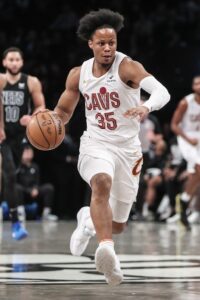
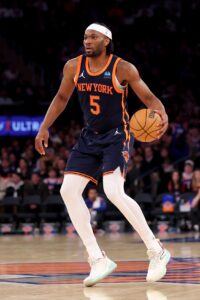
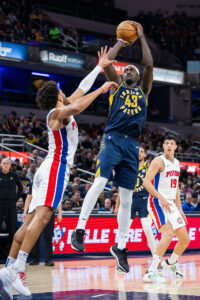 In January, the Pacers
In January, the Pacers 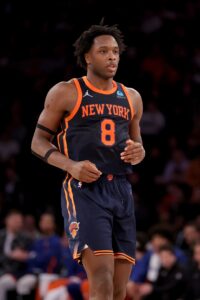 From the Knicks’ perspective, the trade broke down as follows:
From the Knicks’ perspective, the trade broke down as follows: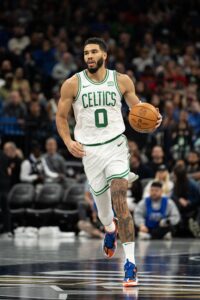 After adding
After adding 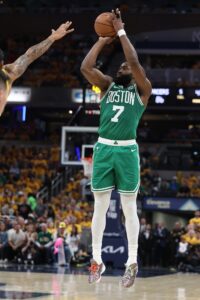
 Buoyed by better chemistry between Doncic and Irving and the addition of rookie center
Buoyed by better chemistry between Doncic and Irving and the addition of rookie center 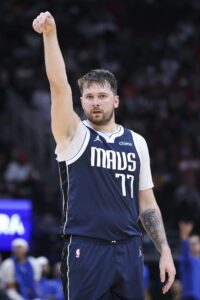
 In their first season with Gobert, the Timberwolves took a step back, winning just 42 games after posting a 46-36 record in 2021/22, and the three-time Defensive Player of the Year struggled to adapt to his new situation. When the 2023 offseason got underway, there were myriad calls from pundits and fans for Minnesota to break up its frontcourt by trading either Gobert or (more likely)
In their first season with Gobert, the Timberwolves took a step back, winning just 42 games after posting a 46-36 record in 2021/22, and the three-time Defensive Player of the Year struggled to adapt to his new situation. When the 2023 offseason got underway, there were myriad calls from pundits and fans for Minnesota to break up its frontcourt by trading either Gobert or (more likely) 
